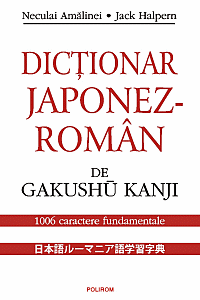 Japanese Language online course. Japanese Language online course.
For information please email us or complete the form in the contact page.
|
|
 |
| |
 Japanese-Romanian Gakushū Kanji Dictionary Japanese-Romanian Gakushū Kanji Dictionary
Authors: Neculai Amalinei, Jack Halpern
Polirom Publishing House, Iasi, 2011.
Cardboard Edition
1088 pages, 130x200 mm
ISBN: 978-973-46-1218-5
Price: 72.20 RON
Available: Yes
:: Order online ::
|
 |
This dictionary covers the 1,006 kanji from Jöyö Kanji that are taught in the first six grades in
the Japanese compulsory school. All the kanji presented are indexed by the On-kun reading, radical
and SKIP code.
The Japanese-Romanian Gakushū Kanji Dictionary is based on the Kodansha Kanji Learner's Dictionary
(KALD) edited by Mr. Jack Halpern, which has already become established as a standard reference
work and enjoys an excellent reputation among scholars, educators, and learners of Japanese throughout
the world. Therefore, this dictionary incorporates most of features of its parent work, including
meanings, detailed character meanings, stroke order diagrams, numerous compounds and a speedy indexing
system for kanji identification.
The main goal of this dictionary is to facilitate an in-depth understanding of the fundamental 1,006
kanji, Gakushū Kanji (Educational kanji), from the compulsory Japanese school. In this way,
the learner is guided to a thorough understanding of how kanji are used in contemporary Japanese,
by providing instant access to a wealth of useful information on the meanings, readings, and compounds
for the most frequently used kanji.
An unique and representative feature of the dictionary is the core meaning, a concise keyword that
defines the most dominant meaning of the 1,006 fundamental Kanji used in the elementary Japanese
school. Each of these character is followed by in-depth meanings that clearly show how a few thousand
basic building blocks are combined to form countless compound words.
The core meaning is completed by the character meanings illustrated by numerous compounds and examples.
Thus, the core meaning and the character meanings act as an integrated unit built in a logically
and structured manner.
Another representative feature of this dictionary is the System of Kanji Indexing by Patterns (SKIP).
This system was developed and patented by Mr. Jack Halpern. SKIP is introduced in his kanji dictionaries
for ordering the main entries.
The advantage of this system is rendered by the facility of learning and easiness in use. Therefore
the characters might be determinated in a quick and accurate manner. Because of the efficiency
of the SKIP system, the Japanese-Romanian Gakushū Kanji Dictionary is a real and convenient learning
tool.
The modern linguistic theory and sophisticated information technology were also integrated in order
to create a dictionary that can be used by beginning and intermediate learners with equal ease and
pleasure.
The authors:
Neculai Amalinei (b. 1951). Research engineer, translator, Editor-in-Chief.
Active in linguistics and Japanese Culture. Editor-in-Chief of the “Kanji in 60 texts”
published by Business Print Publishing House, with the financial aid of Japan Foundation, Urawa,
Japan.
His textbook “Japanese Language. Simply and Efficiently” was published by Polirom Publishing
House in four editions.
President, The Shōgun Center for Japanese Studies, Iasi, Romania.
http://www.shogun.ro
Jack Halpern CEO & President, CJK Dictionary Institute, Editor in Chief, Kanji Dictionary
Publishing Society; Editor-in-Chief of the New Japanese-English Character Dictionary and Kanji Learner’s
Dictionary, published by Kenkyusha and NTC, 1990 and Kodansha International, 1999.
http://www.cjk.org
Scientific referents:
James Breen, PhD, former professor at Monash University, Australia, Visiting Professor at
Research Institute for the Languages and Cultures of Asia and Africa (ILCAA) - Tokyo University
of Foreign Studies (Japan) and also a member of the board of the Japanese Studies Centre (Australia).
James Breen is a top personality both in the research activity linked with digital/ data communications
and the work applied in computational linguistics, particularly in areas related to Japanese
electronic dictionaries and text processing. He is also the compiler of KANJIDICT and EDICT electronic
dictionary databases.
Dr. Ken Lunde, PhD, Senior Computer Scientist, CJKV Type Development, Adobe Systems Incorporated.
Ken Lunde received his Doctor of Philosophy degree in linguistics in 1994 with the dissertation
entitled Prescriptive Kanji Simplification.
Author of "CJKV Information Processing", O' Reilly, Tokyo 1999, he is an outstanding professional CJKV Font Maker and a renown world personality related with the complex Asian languages - Chinese, Japanese, Korean and Vietnamese.
|
|
|